An Evaluation of Explicit Receptor Flexibility in Molecular Docking Using Molecular Dynamics and Torsion Angle Molecular Dynamics
- PMID: 20160879
- PMCID: PMC2772076
- DOI: 10.1021/ct900262t
An Evaluation of Explicit Receptor Flexibility in Molecular Docking Using Molecular Dynamics and Torsion Angle Molecular Dynamics
Abstract
Incorporating receptor flexibility into molecular docking should improve results for flexible proteins. However, the incorporation of explicit all-atom flexibility with molecular dynamics for the entire protein chain may also introduce significant error and "noise" that could decrease docking accuracy and deteriorate the ability of a scoring function to rank native-like poses. We address this apparent paradox by comparing the success of several flexible receptor models in cross-docking and multiple receptor ensemble docking for p38α mitogen-activated protein (MAP) kinase. Explicit all-atom receptor flexibility has been incorporated into a CHARMM-based molecular docking method (CDOCKER) using both molecular dynamics (MD) and torsion angle molecular dynamics (TAMD) for the refinement of predicted protein-ligand binding geometries. These flexible receptor models have been evaluated, and the accuracy and efficiency of TAMD sampling is directly compared to MD sampling. Several flexible receptor models are compared, encompassing flexible side chains, flexible loops, multiple flexible backbone segments, and treatment of the entire chain as flexible. We find that although including side chain and some backbone flexibility is required for improved docking accuracy as expected, docking accuracy also diminishes as additional and unnecessary receptor flexibility is included into the conformational search space. Ensemble docking results demonstrate that including protein flexibility leads to to improved agreement with binding data for 227 active compounds. This comparison also demonstrates that a flexible receptor model enriches high affinity compound identification without significantly increasing the number of false positives from low affinity compounds.
Figures

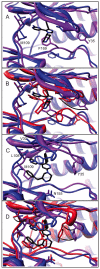
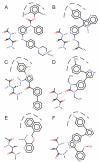
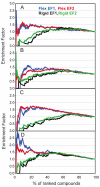
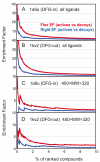
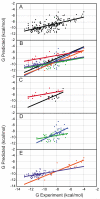
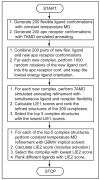
Similar articles
-
Flexible CDOCKER: Hybrid Searching Algorithm and Scoring Function with Side Chain Conformational Entropy.J Chem Inf Model. 2021 Nov 22;61(11):5535-5549. doi: 10.1021/acs.jcim.1c01078. Epub 2021 Oct 27. J Chem Inf Model. 2021. PMID: 34704754 Free PMC article.
-
Flexible CDOCKER: Development and application of a pseudo-explicit structure-based docking method within CHARMM.J Comput Chem. 2016 Mar 30;37(8):753-62. doi: 10.1002/jcc.24259. Epub 2015 Dec 21. J Comput Chem. 2016. PMID: 26691274 Free PMC article.
-
CIFDock: A novel CHARMM-based flexible receptor-flexible ligand docking protocol.J Comput Chem. 2022 Jan 15;43(2):84-95. doi: 10.1002/jcc.26759. Epub 2021 Nov 6. J Comput Chem. 2022. PMID: 34741467
-
Advances in Docking.Curr Med Chem. 2019;26(42):7555-7580. doi: 10.2174/0929867325666180904115000. Curr Med Chem. 2019. PMID: 30182836 Review.
-
Flexible receptor docking for drug discovery.Expert Opin Drug Discov. 2015;10(11):1189-200. doi: 10.1517/17460441.2015.1078308. Epub 2015 Aug 26. Expert Opin Drug Discov. 2015. PMID: 26313123 Review.
Cited by
-
Molecular Dynamics as a Tool for Virtual Ligand Screening.Methods Mol Biol. 2024;2714:33-83. doi: 10.1007/978-1-0716-3441-7_3. Methods Mol Biol. 2024. PMID: 37676592
-
Incorporation of protein flexibility and conformational energy penalties in docking screens to improve ligand discovery.Nat Chem. 2014 Jul;6(7):575-83. doi: 10.1038/nchem.1954. Epub 2014 May 25. Nat Chem. 2014. PMID: 24950326 Free PMC article.
-
Evaluation of several two-step scoring functions based on linear interaction energy, effective ligand size, and empirical pair potentials for prediction of protein-ligand binding geometry and free energy.J Chem Inf Model. 2011 Sep 26;51(9):2047-65. doi: 10.1021/ci1003009. Epub 2011 Jun 6. J Chem Inf Model. 2011. PMID: 21644546 Free PMC article.
-
Prediction of consensus binding mode geometries for related chemical series of positive allosteric modulators of adenosine and muscarinic acetylcholine receptors.J Comput Chem. 2017 Jun 5;38(15):1209-1228. doi: 10.1002/jcc.24728. Epub 2017 Jan 28. J Comput Chem. 2017. PMID: 28130813 Free PMC article.
-
Receptor-ligand molecular docking.Biophys Rev. 2014 Mar;6(1):75-87. doi: 10.1007/s12551-013-0130-2. Epub 2013 Dec 21. Biophys Rev. 2014. PMID: 28509958 Free PMC article. Review.
References
Grants and funding
LinkOut - more resources
Full Text Sources
